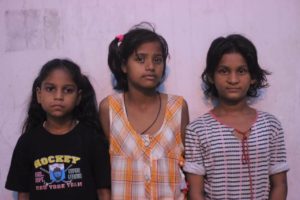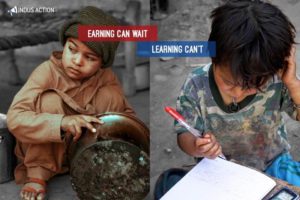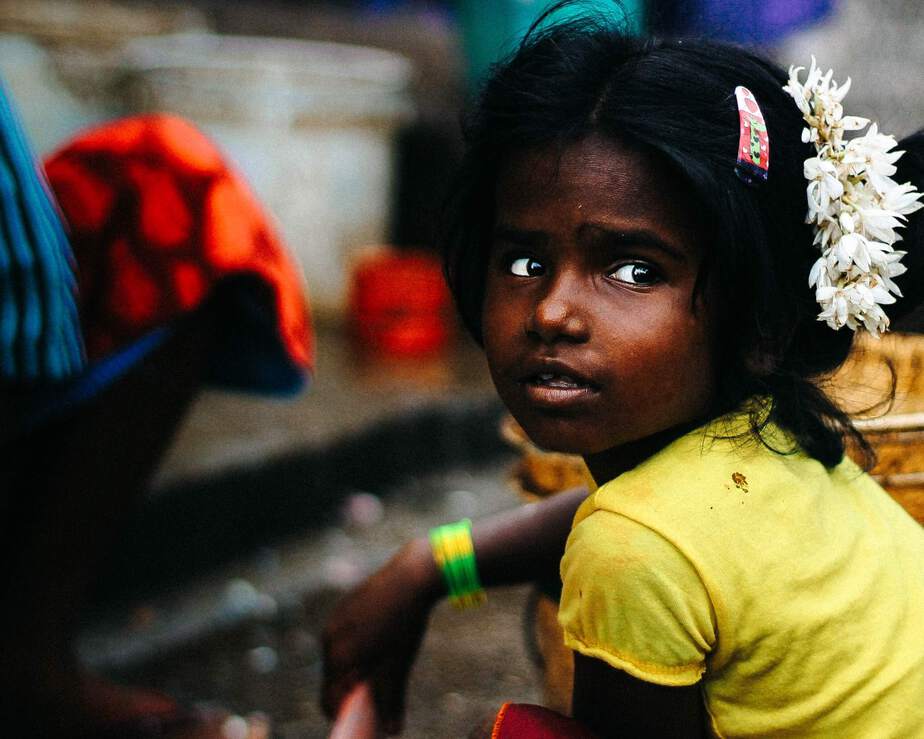Co-authored by Evita Rodrigues and Sanya Sharma
As the traffic light turns red, I hear a knock on the taxi window. Looking out, I see a tiny figure tiptoeing to peer through. She’s thin; too thin. Wearing what must have once been a bright yellow dress, now tattered and soiled, she looks earnestly at me with a single-toothed smile.
I stare at her thin brown hair, patchy skin and protruding bones and wonder: when was the last time she had something to eat? She holds out a children’s storybook— her ware to peddle for the day. Her pleading eyes signalled me to make the purchase.
I wonder, will she ever be able to read the book she is selling?
According to the 2011 Census, India is home to 1.77 million homeless people living in households. Over 47,000 of them live in Delhi alone, and 32,500 are children. Among the various categories of Indian children in difficult circumstances, it is estimated that children on the street are the most rapidly growing group in urban India. A major proportion of these children fall into the age group of 6-14 years, entitling them to free and compulsory education under the Right to Education (RTE) Act.
Children living on the streets usually beg or work to support their families, which earn an insufficient income and are frequently underemployed or unemployed. Additionally, the unregulated market still demands cheap labour from minors, which makes potential breadwinners out of children, especially in the case of unclaimed or orphaned children.
Without access to a proper diet, healthcare, education, safe shelter (or any shelter at all), and at times even a family, these children seem to exist as non-citizens in a State that shows little regard for them. This compounding of vulnerabilities makes access to and attainment of education a far greater challenge for them than for other children.
“Enrolling children from underserved communities in formal schools is a challenging task, often compounded by the fact that many of them are unwilling to join themselves mainly due to lack of initiation into schooling from an early age, along with the fact that their parents and families often live in strenuous circumstances where survival is far more important than an education and education always becomes an “opportunity cost” vis a vis “survival” in those circumstances for that family in question.”
-Jaswinder Singh, Protsahan India Foundation
Mehul’s Aadhar
Nine-year-old Mehul* lives on the street with his father, who is a ragpicker. His father tried enrolling him in a school but was denied admission for lack of a permanent residence. After missing out on two admission cycles, he was finally enrolled after an NGO helped him make an Aadhar card using their organizational address. Now, Mehul wants to become a doctor.
Earlier this year, the All India Parents Association identified over 400 children who were denied admissions in schools on the pretext of not being able to submit identification proof related to age, address, and bank details. This directly violates the RTE Act, which prohibits schools from denying admission to a child on any grounds, including lack of age proof.

The identification requirement is defended on the grounds that many students are due to receive money under several government schemes (such as scholarships for minorities or girls), which mandate a bank account. It is also considered to be a check against double-enrollment to ensure that individuals do not draw benefits from two schools at the same time.

For children like Mehul, who do not have a stable shelter, let alone a permanent address, Aadhar cards and bank accounts are unrealistic options. Most parents are unaware of how to procure the required documentation. Additionally, each day spent in the cumbersome process to create identification documents is a day without any income for wage-labourers like his father.
“They don’t even hit us; instead they let us watch cartoons!”
Soni* (age 18) dropped out of school in her primary years after she was physically abused by a teacher. Ever since the incident, she has been repulsed by classrooms. But remedial classes at an NGO were a pleasant surprise to her: “Maarte bhi nahi, balki cartoons dikhate hain!” (they don’t even hit us; instead, they let us watch cartoons!).
Her parents want her to get married and discourage her from studying, so she now teaches part-time at the NGO to fund her education. Determined to study, she believes that only when girls are educated can they realize the injustice around them and raise their voices.

Children on the streets are often put into shelters to keep them from begging and to provide them with an education instead. However, their safety here is reported to be compromised due to sexual abuse, physical violence, and mental bullying. Soni is just one of the many children who are deterred from education owing to abusive experiences.
Shelter homes run for children on the street were only recently brought under the Juvenile Justice Act 2015. However, issues such as inadequate budget allocation, lack of monitoring and capacity building as well as the sheer dearth of skilled and motivated professionals compromises the safety and well being of children in these homes.
According to Soha Moitra at CRY, “Often, the personnel-in-charge at these homes would be on additional duty; this job not being their priority makes the situation even graver. There need to be performance indicative measurements to assess the efficacy of systems.”
From Kali Mandir to Shiksha Mandir
Nidhi* (age 12) was enrolled in school for the very first time this June. She has been living with her grandmother after her parents separated. Her grandmother can barely afford to look after her, other than putting a roof over her head. Nidhi spent most of her childhood begging outside Kali Mandir. After undergoing a bridge course with an NGO, she was enrolled in a nearby government school.
The RTE Act mandates that children who are out of school must be enrolled into an ‘age appropriate class’ (‘a class where the child would normally be if she had joined school from class 1 at six years of age’). However, this includes a provision for special education to bring children to their peer learning level in a specified period of ‘three months to 2 years’.

Kamal Gaur at Save the Children tells us, “There is no data that specifically tracks the enrollment of these children or their learning outcomes, but considering the general NAS and ASER reports logical deductions can be made. RTE compliance is extremely low in India, and there is a severe lack of age-appropriate training in schools, leaving the onus on NGOs to conduct these bridge courses.”
Children like Nidhi are able to cope with age-appropriate classes because of support from NGOs, but what about the majority of children on the streets who don’t have this access to this kind of help?
The girl outside my window in the tattered yellow dress is only one of hundred thousand nameless and faceless children on Delhi’s streets. From Mehul’s lack of identity to Soni’s unsafe environment or Nidhi’s learning gap, we cannot dismiss the staggered hurdles in Her path to reading the storybook she sells. Without access to a stable (and quality) education, these children risk being trapped into an intergenerational cycle of deprivation and poverty. The ropes to reach their dreams are dangling just out of their reach.
This is Part One of a two-part series by The Bastion that explores the challenges and potential in educating one of the most marginalized and invisibilized groups in India— the children on the street. Click to read Part Two: From Streets to Schools: Making the Invisible Visible
Read the full interviews of some stakeholders’ insights:
*Names have been changed
Photo by Aman Bhargava on Unsplash







[…] From Streets to Schools: The Girl in a Yellow Dress […]
Very well researched one with sharp focus on the issue. We need to have a very comprehensive approach to empower this marginalised group, that should have education plus elements. keep up the good work, thebastion. All the best. RCM Reddy
A worth reading article and beautifully written- have shared this on FB. Dear wonderful authors, don’t stop writing on such issues. We need writers like you to spread the awareness so that we can help child learn, develop and earn a quality life.
Kudos to the team!
My special thanks ?
A worth reading article and beautifully written- have shared this on FB. Dear wonderful authors- don’t stop writing on such issues. We need writers like you to spread the awareness so that we can help child learn, develop and earn a quality life.
Kudos to the team!
My special thanks ?
Well researched, well written. Good job.
Thanks Evita and Sanya for this article — an eye opener to most of us — Young people (in college or just out of college) from CRY and ChildHelp have been visiting families in our Defence Colony, Alto Porvorim and I am sure have collected quite substantial contributions — but surely there is more that each of us can do in this cause of education — I have retired and have plenty of time — I could teach youngsters here at my home during the afternoon and early evening since most Goan schools seem to close around 13:00 hours.
Since most of us are on pensions with limited funds and ever rising prices there may not be scope for larger financial contributions but we all have one commodity that we can share — our time and our knowledge.
Please do let me know how I can help.
Thanks and good luck in all you are doing.
Aloysius D’Souza
Well done Evita and Sanya, for an an article well researched and presented.
Rahul Tripathi
A well researched article which has touched upon very pertinent aspects of the issue of under-privileged children being deprived of education.
Evita Rodrigues ex cbse topper chose to follow fathers footsteps.excellent article.this is just a start,will follow you girl.
A great article! The issue of RTE implementation specifically in the context of homeless children is an extremely pertinent one, and the article does a good job of socio-politically contextualising the issue. Most importantly, it gives a multi-faceted perspective into the lives of children on the street, and the specific obstacles and circumstances that prevent them from gaining an education. Eager to read the second-part!
Beautiful potrait of unheard knocks on glass windows, which may get some attention now. Quiet a real picture on current literacy situation of our country. May this voice reaches to all who are always ready to comment and instead come little forward to support street children around them with a new perspective.
Superb
Well written, it provokes the reader to think about the street children and their right to education. The problem is much more severe than merely access to education, it’s about providing them the hope for a decent quality of life. As rightly pointed out, the challenges are many and it is only some of the NGOs who are working towards giving them a safe shelter to pursue their education. What about the role of the government? It will take a lot of political and social will to change the situation. But when it does, it will not only transform their lives, but also reduce the crime rate and make our country all the more richer by harnessing this huge potential manpower.